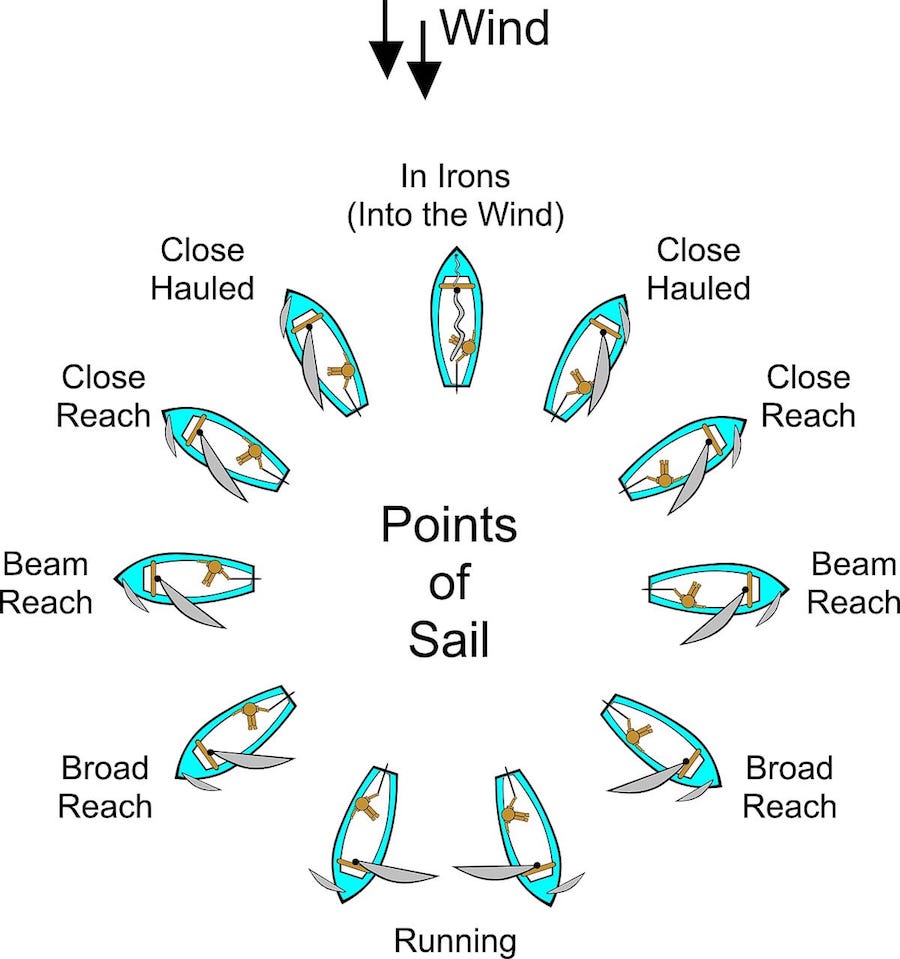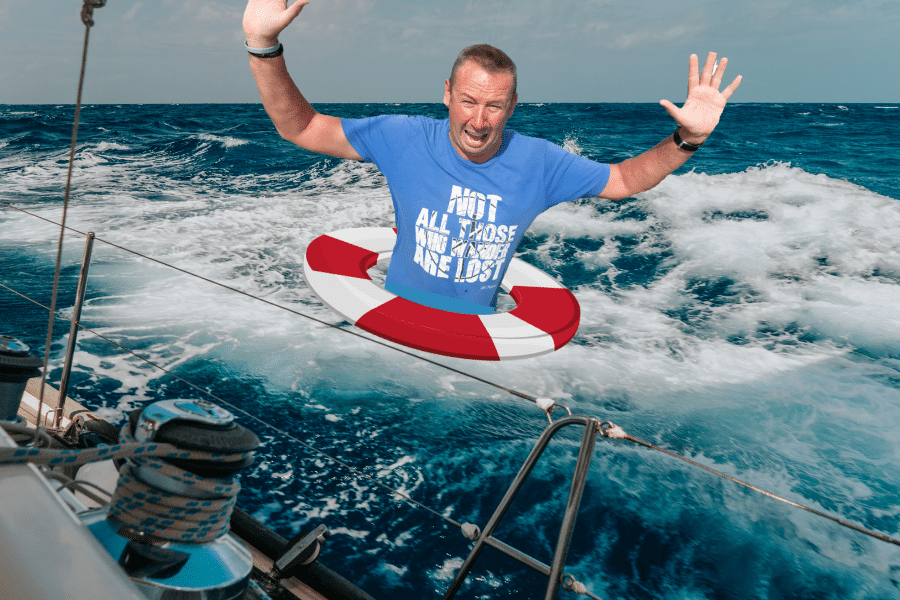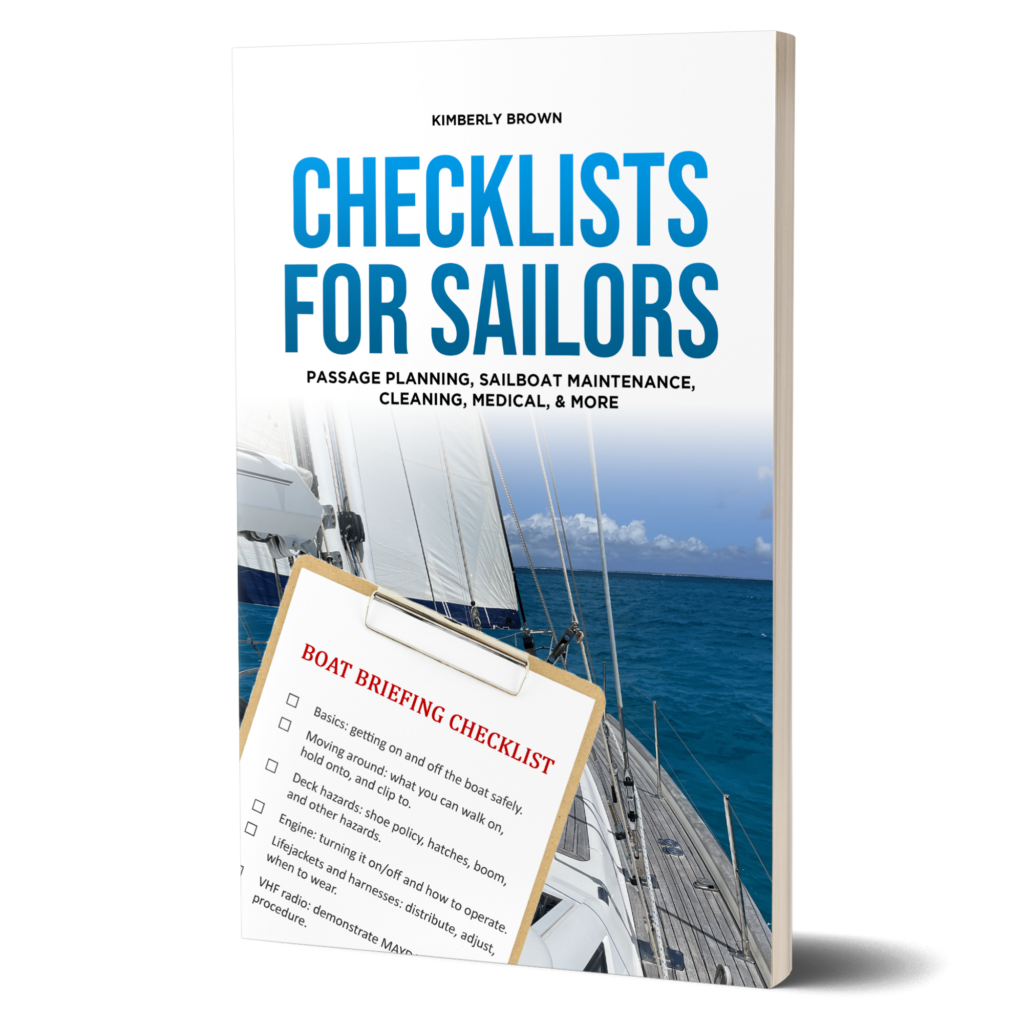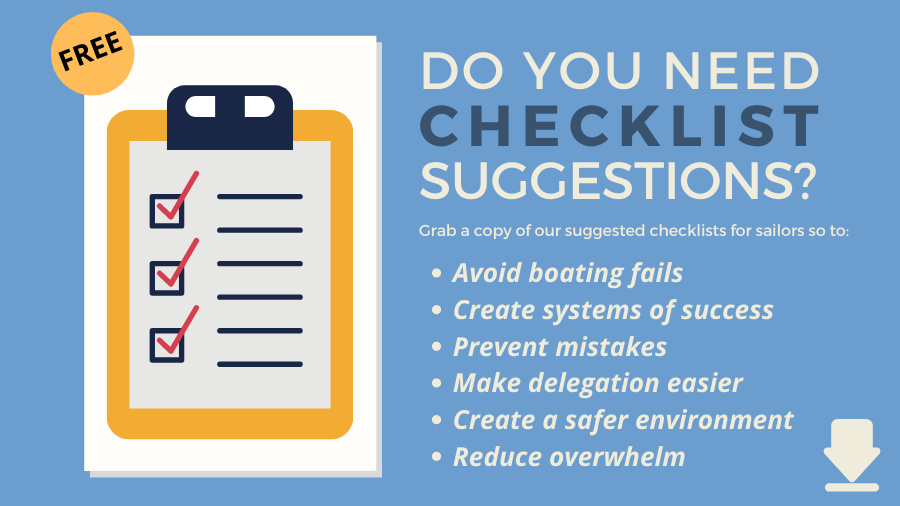When it comes to sailing and sailboats there are several different ways to do a variety of tasks. Some captains and sailing schools preach one method and others preach another. Your best bet is to understand the options and then choose the system, or way, that works best for you.
How will you know what works best for you?! You make sure to schedule time to do Man Overboard (MOB) drills. Also, make sure you have an Overboard Location Alert System in addition to Personal Locator Beacon.
The Heave-to and Drift Method
We practice this method by doing drills using one of our fenders, named Jimmie. By practicing, the procedure becomes second nature. Watch the video and then continue reading below to view our Man Overboard Checklist.
We use the Heave-to and Drift method because it’s the fastest and easiest method. There are very few steps and it’s actually difficult to get it wrong. No sails need to be dropped, the casualty is approached in the least scary way (beam to the casualty) rather than bow heading for the casualty.
So, what happens when someone (or something) goes overboard?
Man Overboard Drills Checklist
- Yell ‘Man Overboard’ and point to the casualty. If several people are on board, the person who sees the casualty doesn’t take his or her eyes off the person in the water. They just keep pointing and all available crew does the following…
- Press the Man Overboard alarm button to mark the location where the casualty went over.
- Throw all Man Overboard devices in the direction of the casualty, such as flotation devices and the Jon Buoy.
- Turn the boat into a beam reach, allowing the wind to hit the boat along the beam or the side of the boat. See the wind chart below. (Tip: make it a routine to ask yourself from time to time, ‘If I have to turn the boat into a beam reach, which way do I need to turn?’).
- Start the engine.
- Head forward for two boat lengths (this will allow you to put enough space between you and the casualty)
- Bring the sails in as tight as possible if they’re not already in.
- Turn the boat into the wind, forcing the headsail to flop onto the wrong side without releasing any lines (called heaving-to or a crash tack). This is also called a man overboard rescue turn, which will slow the boat down almost to a stop. It will also place the boat downwind of the casualty so the causally will float towards the boat rather than away.
- Use the engine to go forward and reverse, lining the casualty up to the beam, or side, of the boat. You’re not steering towards the casualty. Rather, you are letting the casualty drift back to you and providing the whole boat as a mechanism to grab them.
- All crew members to line up along the side of the boat, with a man overboard pole in hand, offering the casualty peace of mind that you’re coming and preparing to lift him or her out of the water.

Man Overboard Considerations
As soon as someone goes overboard it is a life and death situation. Get someone on the VHF radio to do a MAYDAY and activate the DSC alarm system.
If you need a template for how to activate the DSC system and the exact words to read for a MAYDAY, customizable to your MMSI, Call Sign and Boat name, consider purchasing my ‘VHF Radio Checklists And Templates For Sailors’
Once you’re lined up to the casualty, it might not be possible to lift them out of the water by hand or with a pole. Discuss what options are available so that you’re prepared for the worst.
For example, if Simon falls overboard, I will most likely not be able to pull him out. If he’s conscious and the boat isn’t slapping around, I can get him to the back of the boat and help him up the swim ladder.
Be warned, however, that in big seas it’s not safe to try and get on board with the stern slapping. It could clonk the casualty on the head and knock them out!
My other options are to attach a halyard to Simon and hoist him up onto the deck or use our outboard crane to get him back on board.
Secondary Drowning Is A Real Threat
Secondary or “delayed” drowning happens when the casualty inhales water into his or her lungs, causing inflammation or edema (swelling). The edema can occur hours or even days after the initial contact with water. Death from delayed drowning is due to swelling of the small air sacs in the lungs, preventing oxygen from entering the bloodstream.
Anyone that has been recovered from an incident needs to be under supervision for at least 24 hours. Keep an eye out for:
- Difficulty breathing
- Persistent coughing
- Choking
- Lethargy or sleepiness
- Irritability
- Vomiting
A Man Overboard is a Life-Threatening Event
Make sure to take MOBs very seriously. Understand that it’s not a good idea to jump into the water to try and rescue a casualty! Practice the various ways to perform a Man Overboard procedure by doing drills with a fender or other flotation device. Think about what you’d do if your partner went over—how would you get them back into the boat?
No one wants to even think about things like this happening but if you don’t it could mean a life. A life! Do the drills, understand your options, and get to a point where you’re confident in yourself. Doing this small task will benefit everyone.

And if you’d like to learn how to do MOB Drills on your boat or one of ours, check out our Sailing Lifestyle Experiences. We’ll teach you what you need to become more confident in sailing and sailboat management.
And if you like Checklists, make sure to purchase my bestselling guide Checklists For Sailors.
“After months of drafting my own inadequate checklists, a friend recommended Kimberly Brown’s book Checklists for Sailors. I never realized that there were so many aspects to sailing that this very comprehensive and complete book covers in ensuring that risks are minimized through thorough pre planning.
In addition, the offer of the Microsoft Word soft copy has allowed me to modify, consolidate and tailor these checklists to my own personal needs. As a serious sailor in Australia and the Pacific, I would highly recommend this book.” Trevor James Bavaria 45 Cruiser
Also, check out these resources:
- Boat Safety 101
- Check out all our checklist articles and videos here: Checklists
- Get 50+ Checklist Suggestions here: Suggested Checklists For Sailors
- Also, check out our shop for a variety of guides that include checklists here: Britican Shop


Love this. Learned the typical ASA version of the figure eight, but agree this is much better.
Cheers.
It makes so much sense 🙂 Thank you for commenting Chris.
Your words are wrong.
” It will also place the boat downwind of the casualty so the causally will float towards the boat rather than away”
This maneuver places the boat upwind of the casualty and the boat floats downwind to the causality. It is explained right in the video.
Let me know if I don’t get the concept.
Steven
Your right Steven…I need to change that! Thank you for pointing that out. Smiles, Kim
Hello, I was very surprised when I saw your MOB technique in YT. I thought it was only known as HamburgerManoever in Germany. I am very interested to know who taught you this technique.
Also I was not familiar with the name “heave-to and drift method”
I am delighted that you are one of the few English-speaking sailors to use this technique.
I can of course be mistaken, but as far as I know, this MOB rescue maneuver was developed on the S/V Charisma by Constantin Claviez.
Hey A.H. – Our RYA (British sailing association) instructor taught us this maneuver in 2012 when we did our Day Skippers off the south coast of Portugal. It’s so much better than the alternatives. We’ve never used any other way when practicing MOB drills. Smiles, Kim
I also prefer and practice this maneuver.
I have packed a dynema sling inside the life wests attached to the safety harness of the life west. So when the person is next to the boat you can lift up the sling with a pole and connect it to a haylard. I use another slings in different lengths to build very quick a step for the person outside the hull by putting the sling around the stanchion. Hope I´ll never will need to do this in real. Thank you for sharing this video and the checklist.
Great set-up Gerhard. Thank you for sharing! Kim